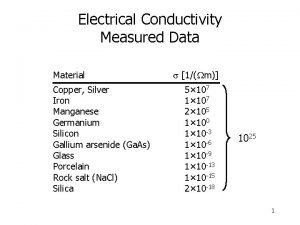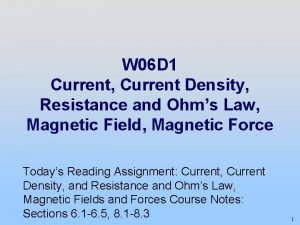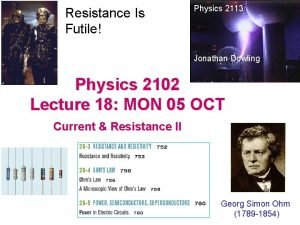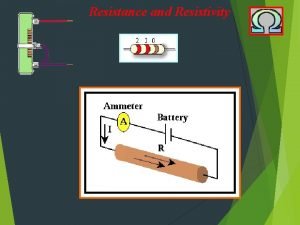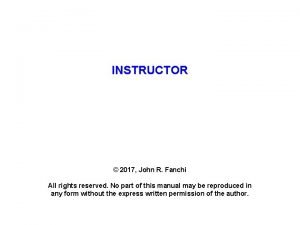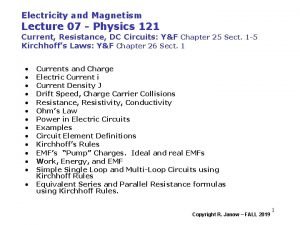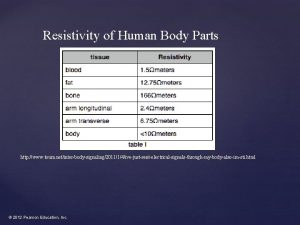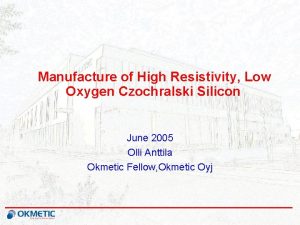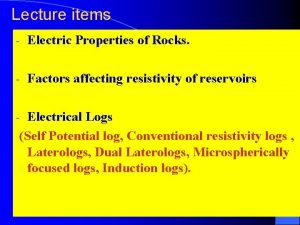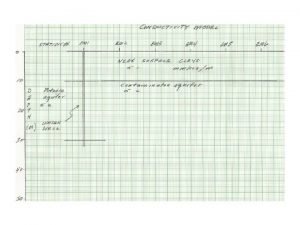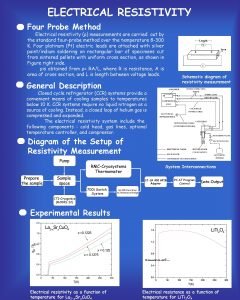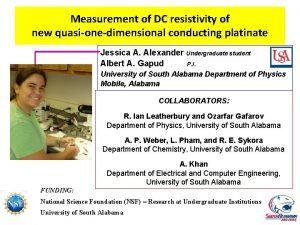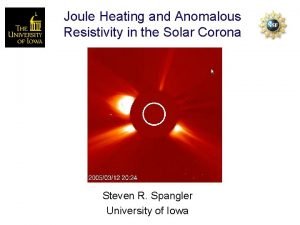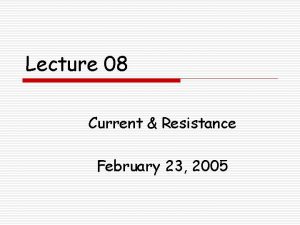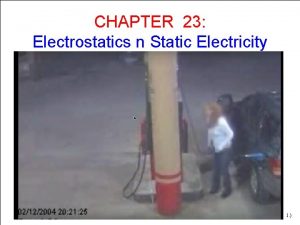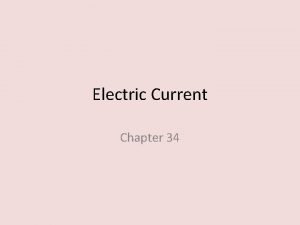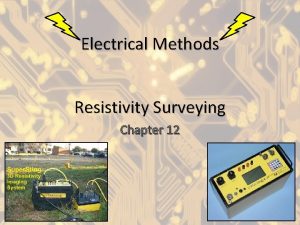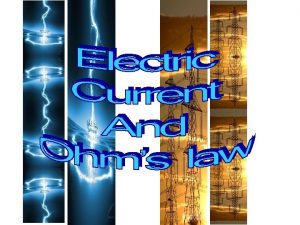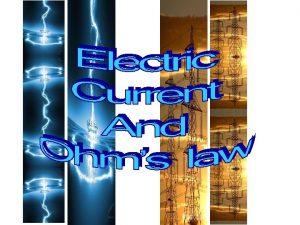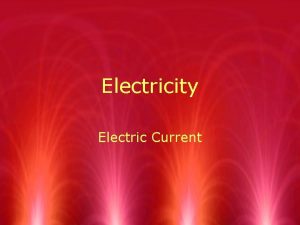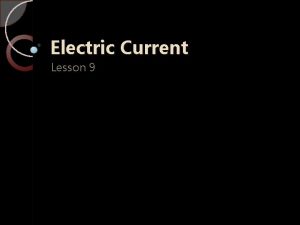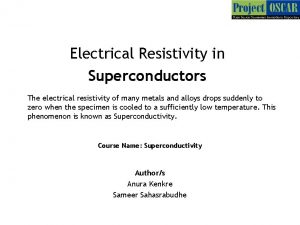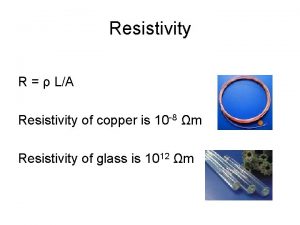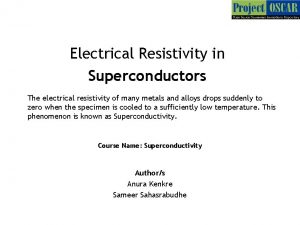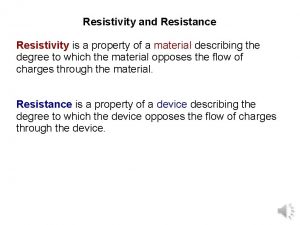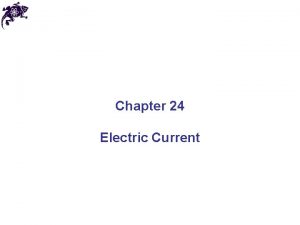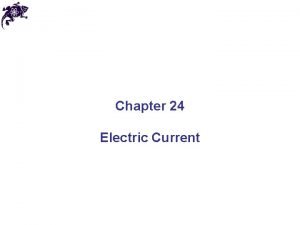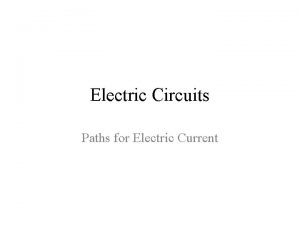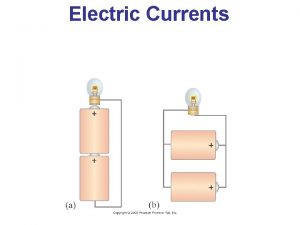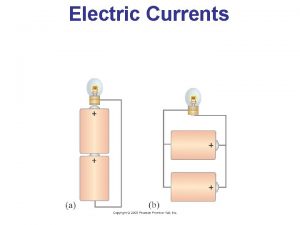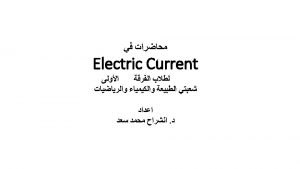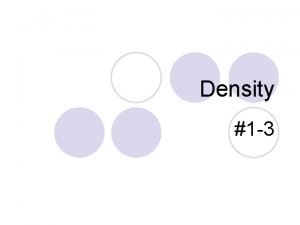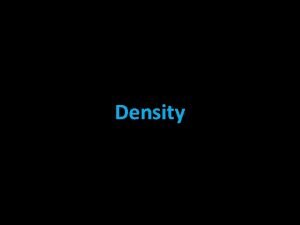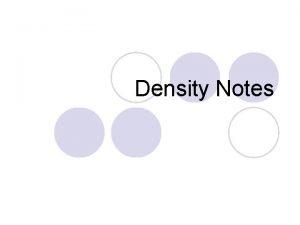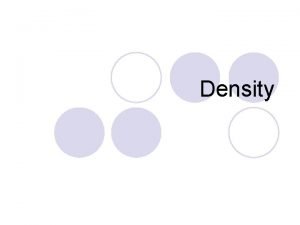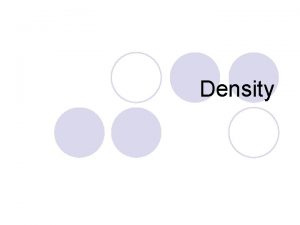Electric Current Chapter 27 Electric Current Density Resistivity
























![Resistivities of Selected Materials Material Resistivity [ m] Aluminum Cooper Iron 2. 65 x Resistivities of Selected Materials Material Resistivity [ m] Aluminum Cooper Iron 2. 65 x](https://slidetodoc.com/presentation_image_h2/7d9c6b4f5e65afe901c5732f929382fa/image-25.jpg)

- Slides: 26

Electric Current Chapter 27 Electric Current Density Resistivity – Conductivity - Resistance Ohm’s Law (microscopic and macroscopic) Power Dissipated

Motion of a Point Charge in an Electric Field A particle of mass m and charge q, placed in an electric field E, will experience a force F = q E F=q. E=ma q • a E The particle will accelerate with acceleration: a = (q/m) E In one dimension the motion of the particle is described by: x = x 0 + v 0 t + a t 2/2 v = v 0 + a t v 2 = v 02 + 2 a (x – x 0)

Motion of a Point Charge in an Electric Field Between the plates of a parallel plate capacitor (vacuum) L q • m a The charge accelerates with a = (q/m) E = (q/m) (V/L) V If the particle (with charge q) starts at rest, and the potential difference between the plates is V, then the kinetic energy upon reaching the second plate will equal the change in potential energy: K = m v 2 / 2 = q. V (e)(1 V)=1 e. V = 1. 6 x 10 -19 J ELECTRON VOLT

Electron motion in a conductor E=0 You probably think of the conduction electrons as normally sitting still unless pushed by an electric field. That is wrong. Electrons are in constant motion. (And it is fast – around 10% of the speed of light. ) But their motion is random – and constantly changing as they bounce off of impurities. Because of the random motion no net flow occurs.

Electron motion in a conductor E=0

Electron motion in a conductor E=0 E • An electric field accelerates the electrons (along -E) and so modifies the trajectories of electrons between collisions. • When E is nonzero, the electrons move almost randomly after each bounce, but gradually they drift in the direction opposite to the electric field. • This flow of charge is called a current.

Electric current I dq passes through a wire in time dt • We define the electric current as the movement of charge, across a given area, per unit time: I = dq / dt • SI unit of current: 1 C/s = 1 Ampere (Amp) • The direction of the current is the direction in which positive charges would move. • Electrons move opposite to the direction of the current.

Current density I Cross-sectional area A • If current I flows through a surface A, the current density J is defined as the current per unit area: J = I/A • After an electron collides with an impurity, it will accelerate under an E field with a = e E / m. • Suppose the average time between collisions is t. Then the average velocity is vd = a t = e E t / m. This velocity is called the electron drift velocity (which turns out to be much less than the speed of light)

Current density A vd vd. Dt Density of electrons: n Number of electrons: N=n(Avd. Dt) • Construct the above volume. • In time Dt all the electrons in it move out through the right end. • Hence the charge per unit time (the current) is I = (N e) / Dt = n e A vd Dt / Dt = n e A vd • The current density is J = I / A = n e vd = (n e 2 t / m) E

Example: What is the drift velocity of electrons in a Cu wire 1. 8 mm in diameter carrying a current of 1. 3 A? In Cu there is about one conduction electron per atom. The density of Cu atoms is

Example: What is the drift velocity of electrons in a Cu wire 1. 8 mm in diameter carrying a current of 1. 3 A? In Cu there is about one conduction electron per atom. The density of Cu atoms is Find vd from J=I/A=1. 3 A/( (. 0009 m)2)=5. 1 x 105 A/m 2

Example: What is the drift velocity of electrons in a Cu wire 1. 8 mm in diameter carrying a current of 1. 3 A? In Cu there is about one conduction electron per atom. The density of Cu atoms is Find vd from J=I/A=1. 3 A/( (. 0009 m)2)=5. 1 x 105 A/m 2 Now use

Example: What is the drift velocity of electrons in a Cu wire 1. 8 mm in diameter carrying a current of 1. 3 A? In Cu there is about one conduction electron per atom. The density of Cu atoms is Find vd from J = I/A = 1. 3 A/( (. 0009 m)2) = 5. 1 x 106 A/m 2 Now use Much less than one millimeter per second!

Ohm’s Law • We found that J= (ne 2 t/m)E, that is, that the current J is proportional to the applied electric field E (both are vectors): •

Ohm’s Law • We found that J= (ne 2 t/m)E, that is, that the current J is proportional to the applied electric field E (both are vectors): • • J= E Ohm’s Law

Ohm’s Law • We found that J= (ne 2 t/m)E, that is, that the current J is proportional to the applied electric field E (both are vectors): • • J= E Ohm’s Law is the Conductivity, = J / E. Units are (A/m 2) divided by (V/m) = A/(Vm)

Ohm’s Law • We found that J= (ne 2 t/m)E, that is, that the current J is proportional to the applied electric field E (both are vectors): • • J= E Ohm’s Law is the Conductivity, = J / E. Units are (A/m 2) divided by (V/m) = A/(Vm) • It is useful to turn this around and define the Resistivity as = 1/s, so E= J. Units of are (V/A)m

Ohm’s Law s and are dependent only on the material, - not its length or area. However, consider a metal rod of resistivity : +V , area A L 0 volts

Ohm’s Law s and are dependent only on the material, - not its length or area. However, consider a metal rod of resistivity : +V , area A L E= J (V/L) = (I/A) V = ( L/A) I 0 volts

Ohm’s Law s and are dependent only on the material, - not its length or area. However, consider a metal rod of resistivity : +V , area A 0 volts L E= J (V/L) = (I/A) V = ( L/A) I V=IR with R= L/A

Ohm’s Law The macroscopic form V = I R is the most commonly used form of Ohm’s Law. R is the Resistance It depends on the material type and shape: R= L/A Units: ohms (W). As = R A / L, common units for the resistivity are Ohm-meters. Similarly, common units for the conductivity s = 1 / are (Ohm m)-1 or Mho/m

Ohm’s Law J= E microscopic form = conductivity = 1/ = resistivity and = 1/ are dependent only on the material, (NOT on its length or area) V = I R macroscopic form R depends on the material type and shape A L R = L / A = resistance

Electrical Power Dissipation • In traveling from a to b , energy decrease of dq is: d. U = dq V • • V a dq b Resistance, R Now, dq = I dt Therefore, d. U = I dt V Rate of energy dissipation is d. U / dt = I V This is the dissipated power, P. (Watts, or Joules /sec)

Electrical Power Dissipation • In traveling from a to b , energy decrease of dq is: d. U = dq V • • V a dq b Now, dq = I dt Resistance R Therefore, d. U = I dt V Rate of energy dissipation is d. U / dt = I V This is the dissipated power, P. [Watts, or Joules /sec] • Hence, or P=IV P = I 2 R = V 2 / R
![Resistivities of Selected Materials Material Resistivity m Aluminum Cooper Iron 2 65 x Resistivities of Selected Materials Material Resistivity [ m] Aluminum Cooper Iron 2. 65 x](https://slidetodoc.com/presentation_image_h2/7d9c6b4f5e65afe901c5732f929382fa/image-25.jpg)
Resistivities of Selected Materials Material Resistivity [ m] Aluminum Cooper Iron 2. 65 x 10 -8 1. 68 x 10 -8 9. 71 x 10 -8 Water (pure) Sea Water Blood (human) 2. 6 x 105 0. 22 0. 70 Silicon 640 Glass Rubber 1010 – 1014 1013 – 1016

What is the resistance of a Cu wire, 1. 8 mm in diameter, and 1 m long ? . R = L / A R = (1. 68 x 10 -8) 1 / (0. 0009)2 R = 6. 6 x 10 -3 What is the voltage difference between the extremes of a Cu wire, 1. 8 mm in diameter, and 1 m long, when the current is 1. 3 A ? . V = I R = (1. 3 A) 6. 6 x 10 -3 = 8. 6 x 10 -3 V What is the power dissipated in a Cu wire, 1. 8 mm in diameter, and 1 m long, when the current is 1. 3 A ? . P = I 2 R = (1. 3)2 6. 6 x 10 -3 W = 1. 12 x 10 -2 W
 Ohm's law microscopic form
Ohm's law microscopic form Conductivity formula
Conductivity formula Electric current density
Electric current density Dimensions of resistance
Dimensions of resistance Resistivity units
Resistivity units Resistivity log
Resistivity log Resistivity depends on
Resistivity depends on Resistivity of human body
Resistivity of human body Cz silicon wafer with high resistivity
Cz silicon wafer with high resistivity Factors affecting resistivity of rocks
Factors affecting resistivity of rocks Work and energy
Work and energy Resistivity unit
Resistivity unit Resistivity by four probe method
Resistivity by four probe method Measurement of dc resistivity
Measurement of dc resistivity Spitzer resistivity
Spitzer resistivity Specific gr
Specific gr Planar density
Planar density What does arithmetic density tell us
What does arithmetic density tell us Linear density of atoms
Linear density of atoms High density low density
High density low density Physiological population density
Physiological population density Chapter 23 electric current circuit happenings
Chapter 23 electric current circuit happenings Electricity
Electricity Chapter 34 electric current
Chapter 34 electric current Chapter 21 electric charge and electric field
Chapter 21 electric charge and electric field Chapter 21 electric charge and electric field
Chapter 21 electric charge and electric field Units of charge
Units of charge

